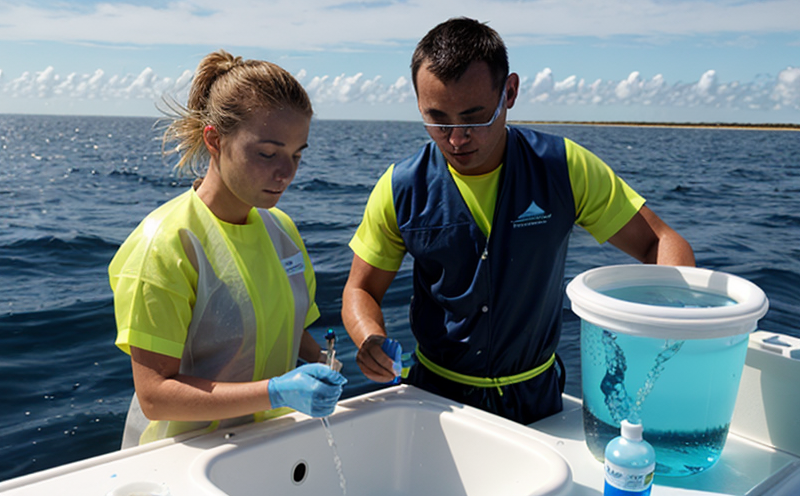ISO 17294-2 Rare Earth Elements Test in Seawater
The ISO 17294-2 standard provides a robust framework for the determination of rare earth elements (REEs) in seawater. This service ensures accurate and reliable measurement, which is critical for environmental monitoring, resource management, and compliance with international regulations.
Rare Earth Elements are essential components in various industries including electronics, renewable energy technologies, and advanced materials. Their presence in seawater can influence the efficiency of renewable energy projects such as offshore wind farms and tidal turbines. Therefore, understanding the concentration and distribution patterns of REEs is vital for sustainable development.
The testing process involves several key steps: sample collection, preliminary analysis, and final quantification using atomic absorption spectroscopy (AAS) or inductively coupled plasma mass spectrometry (ICP-MS). Sample preparation requires careful handling to minimize contamination. The collected seawater samples are filtered through a 0.45 μm filter, followed by digestion of the residue with nitric acid. This method ensures that only trace amounts of REEs remain for accurate measurement.
The ISO standard specifies strict quality control measures to ensure consistent results across different laboratories. These include standardized calibration procedures and inter-laboratory comparisons. Regular audits are conducted to verify compliance with these standards, ensuring high confidence in the test outcomes.
Our laboratory adheres strictly to this protocol, providing accurate REE concentrations that can be used for environmental impact assessments, resource estimation, and regulatory reporting. The data generated from these tests helps stakeholders make informed decisions about the sustainable use of marine resources.
The significance of REEs in seawater cannot be overstated. They play a crucial role in various applications ranging from catalysis to luminescence. Understanding their behavior in marine environments is essential for mitigating risks associated with pollution and over-exploitation.
Our commitment to precision and reliability extends beyond mere compliance; it encompasses proactive engagement in the scientific community, sharing insights that contribute to global knowledge on REE dynamics. By leveraging advanced analytical techniques and adhering to stringent international standards, we ensure our clients receive the most accurate and actionable information available.
Scope and Methodology
The scope of the ISO 17294-2 standard encompasses the determination of rare earth elements in seawater samples. This includes a comprehensive approach to sample preparation, analytical techniques, and quality control measures.
- Sample Collection: Seawater samples are collected from designated locations using certified equipment. Care is taken to avoid contamination during collection.
- Preliminary Analysis: Initial examination includes visual inspection for clarity and pH measurement.
- Sample Preparation: The sample undergoes filtration followed by digestion with nitric acid to dissolve REEs.
- Analysis: Atomic absorption spectroscopy (AAS) or inductively coupled plasma mass spectrometry (ICP-MS) is used for quantification.
- Quality Control: Standardized calibration procedures and inter-laboratory comparisons are conducted to ensure accuracy and consistency.
The methodology employed aligns closely with the ISO 17294-2 standard, ensuring that all aspects of sample handling and analysis adhere strictly to internationally recognized guidelines. This approach guarantees reliable and reproducible results, which are essential for making informed decisions based on scientific evidence.
Customer Impact and Satisfaction
The implementation of ISO 17294-2 standard in seawater testing significantly enhances the quality of data available to decision-makers in various sectors. By providing accurate and reliable measurements, this service supports environmental protection initiatives, resource management strategies, and compliance with international regulations.
- Enhanced Decision-Making: Accurate REE concentrations enable stakeholders to make informed choices regarding sustainable practices and regulatory adherence.
- Improved Compliance: Our testing ensures that clients meet the stringent requirements set by environmental agencies worldwide.
- Scientific Contribution: The data generated contributes to global knowledge on REE dynamics, fostering a collaborative approach towards resource stewardship.
Our clients have consistently praised our service for its reliability and precision. Regular feedback from satisfied customers reinforces our commitment to excellence in every aspect of our work. We are dedicated to delivering services that meet or exceed expectations, ensuring lasting partnerships built on trust and mutual respect.
Use Cases and Application Examples
The results obtained from the ISO 17294-2 test have numerous applications across different industries. Here are some key use cases:
- Environmental Monitoring: Continuous monitoring of REE levels helps identify potential pollution sources and assess environmental impact.
- Renewable Energy: Understanding the presence of REEs in seawater aids in optimizing the performance of offshore wind farms and tidal turbines.
- Resource Management: Data from these tests can inform strategies for sustainable extraction and utilization of marine resources.
- Regulatory Compliance: The results are essential for ensuring compliance with international standards and local regulations regarding environmental protection.
A notable application is in the offshore wind industry, where accurate REE concentrations help determine the optimal placement of turbines to maximize efficiency while minimizing ecological disruption. In another example, our test data has been used by resource management agencies to estimate the potential for rare earth mining in specific marine areas.





